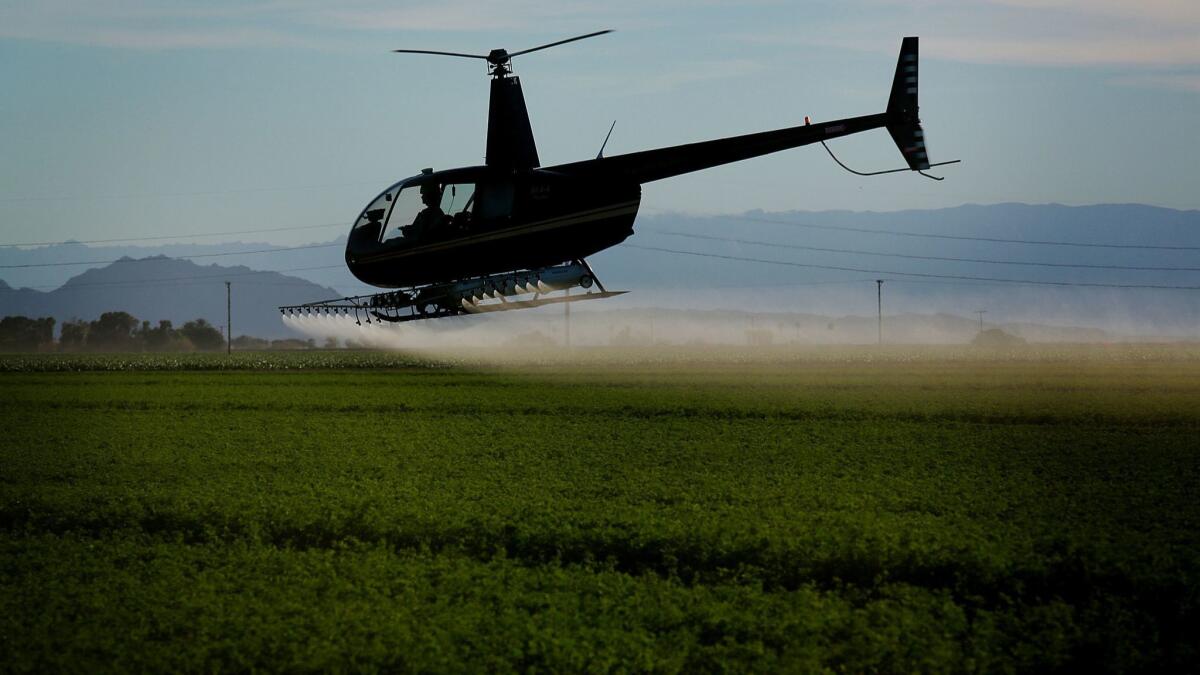California recommends new restrictions on popular pesticide blamed for harming babies

- Share via
California regulators recommended new restrictions Thursday on chlorpyrifos, a widely used pesticide blamed for harming the brains of babies.
The Department of Pesticide Regulation issued temporary guidelines for chlorpyrifos that include banning it from crop dusting, discontinuing its use on most crops and increasing perimeters around where it’s applied.
The Dow Chemical Co. pesticide currently used on about 60 kinds of crops — including grapes, almonds and oranges — has increasingly come under fire from regulators, lawmakers and courts.
A federal appeals court in August ordered the U.S. Environmental Protection Agency to remove the pesticide from sale in the United States after it ruled the Trump administration endangered public health by reversing an Obama-era effort to ban the chemical. The EPA is appealing that 2-1 ruling to a full panel of the 9th U.S. Circuit Court of Appeals.
Hawaii passed legislation in June that will ban the use of the pesticide there in January.
An environmental group blasted California’s new recommendations as toothless and said the state should be taking the pesticide off the market after scientists for three state agencies found it was toxic and couldn’t be safely used at any levels.
“Unfortunately, these are voluntary recommendations for local officials that have no weight of law behind them,” said Paul Towers of the Pesticide Action Network. “Instead of taking this brain-harming pesticide off the market, California officials are again passing the buck.”
California released its recommendations as it considers long-term regulations to restrict the use of chlorpyrifos and designate it as a “toxic air contaminant” that poses a risk of serious illness or death.
Farmworkers in the nation’s leading agricultural state have been sickened several times in recent years when the pesticide drifted.
More than three dozen workers harvesting cabbage in Kern County last year were affected when the pesticide drifted from neighboring farms, causing some to become nauseated and vomit and sending some for medical treatment, the department said.
At least 13 people were affected in four incidents this year, including 10 workers in Solano County, where the pesticide was applied to an almond orchard in July.
The pesticide is in a class of organophosphates chemically similar to a nerve gas developed by Nazi Germany before World War II. Its heavy use has often left traces in drinking water sources. A UC Berkeley study in 2012 found that 87% of umbilical-cord blood samples tested from newborn babies contained detectable levels of the pesticide.
Under pressure from federal regulators, Dow voluntarily withdrew chlorpyrifos for use as a home insecticide in 2000. The EPA placed “no-spray” buffer zones around sensitive sites, such as schools, in 2012.
California’s Department of Pesticide Regulation is recommending that county agriculture commissioners, who issue pesticide application permits, adopt its newly issued restrictions in January so they can protect health.
“This is like our short-term fix,” department spokeswoman Charlotte Fadipe said. “We’ve already started down a longer road to a permanent fix.”
Other recommendations include creating a 150-foot setback from homes, businesses and schools where the pesticide is applied. During applications, there would have to be a quarter-mile buffer zone for 24 hours around any field where the pesticide is applied, and the only people allowed inside the area would be authorized applicators.
The department also recommended limiting use of chlorpyrifos to certain crops to fight specific pests, such as weevils and certain types of aphids on alfalfa, stink bugs on almonds and maggots on leafy vegetables and onions.
UPDATES:
12:55 p.m.: This article was updated with reaction from the Pesticide Action Network.
This article was originally published at 10 a.m.
More to Read
Inside the business of entertainment
The Wide Shot brings you news, analysis and insights on everything from streaming wars to production — and what it all means for the future.
You may occasionally receive promotional content from the Los Angeles Times.










